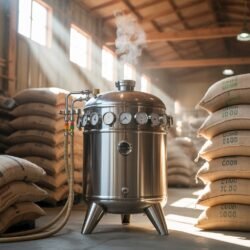Anaerobic fermentation is a delicate art that’s rapidly gaining popularity in the specialty coffee world. But with its promise of bold, complex flavors comes a host of challenges for producers. Ensuring consistent quality, avoiding defects, and harnessing the latest technology are all critical to success. Let’s explore the essential quality control measures, innovative tools, and real-world hurdles that define this exciting frontier in coffee processing.
Monitoring Microbial Activity
At the heart of anaerobic fermentation is microbial activity. Unlike traditional methods, where open-air fermentation relies on wild yeasts and bacteria, anaerobic processing takes place in sealed, oxygen-free environments. This controlled setting allows producers to guide fermentation using specific microbial cultures, but it also means that contamination can spell disaster.
How Producers Keep It Clean:
Producers use strict sanitation protocols, sterilizing tanks and equipment before each batch. Some introduce selected yeast and bacteria strains to ensure predictable, desirable outcomes. Regular sampling and microbiological testing help monitor the health and activity of these microbes, ensuring that only the right ones are at work.
Tracking Sugar Content (Brix)
Sugar content—measured as Brix—plays a crucial role in fermentation. Higher Brix levels mean more sugars available for microbes to convert into acids, alcohols, and esters, which shape the coffee’s flavor profile.
Tools for the Job:
Portable refractometers are a staple on coffee farms, allowing producers to quickly measure Brix levels in cherry samples. By tracking Brix from harvest through fermentation, producers can adjust their process to optimize flavor development and avoid under- or over-fermentation.
Sensory Evaluation: The Human Touch
No matter how advanced the technology, sensory evaluation remains the gold standard for quality control. Trained cuppers taste samples at various stages—during fermentation, after drying, and before export—to assess flavor, aroma, and body.
Consistency Through Training:
Many producers invest in cupping training for their teams, ensuring that everyone speaks the same language when it comes to quality. Regular cuppings help identify defects early, allowing for quick adjustments to the process.
Ensuring Consistency and Avoiding Defects
Consistency is the holy grail of specialty coffee, and anaerobic fermentation is no exception. Producers face unique challenges, such as maintaining the right temperature and pH throughout the process, preventing contamination, and managing the risk of over-fermentation.
Best Practices:
- Temperature Control: Using insulated tanks or climate-controlled rooms to keep fermentation within the ideal range (typically 23–28°C).
- pH Monitoring: Regular pH checks to ensure the environment remains conducive to healthy microbial activity.
- Gas Management: Installing one-way valves to release CO₂ and maintain the anaerobic environment.
- Batch Tracking: Keeping detailed records of each batch’s parameters and outcomes to identify trends and improve future runs.
The Latest Tools and Technologies
The world of anaerobic coffee processing is rapidly evolving, with new tools and technologies helping producers push the boundaries of quality and consistency.
Innovations to Watch:
- Smart Sensors: Wireless temperature and pH sensors that provide real-time data, allowing producers to monitor conditions remotely and make adjustments on the fly.
- Automated Monitoring Systems: Advanced software that tracks fermentation progress, alerts producers to potential issues, and stores historical data for analysis.
- Microbial Inoculation Kits: Pre-selected microbial cultures designed to deliver specific flavor profiles and reduce the risk of contamination.
- Portable Lab Equipment: Handheld devices for measuring Brix, pH, and even microbial activity, making it easier for small-scale producers to maintain high standards.
Challenges on the Horizon
Despite these advances, challenges remain. Anaerobic fermentation is still a relatively new and experimental process, and there’s much to learn about optimizing it for different varieties, altitudes, and climates. Contamination, inconsistent results, and the risk of off-flavors are ever-present concerns, especially for producers just starting out.
Building Resilience:
Producers are tackling these challenges through education, collaboration, and a willingness to experiment. By sharing knowledge and embracing new technologies, the industry is steadily raising the bar for what’s possible with anaerobic coffee.
Summary
Quality control in anaerobic coffee processing is a complex, multidisciplinary effort that blends science, technology, and sensory expertise. By monitoring microbial activity, tracking sugar content, and relying on rigorous sensory evaluation, producers can craft consistently exceptional coffees. As new tools and techniques continue to emerge, the future of anaerobic fermentation looks brighter—and tastier—than ever.


